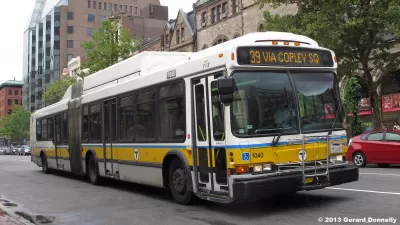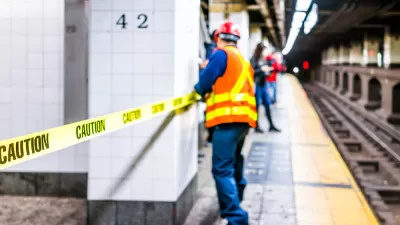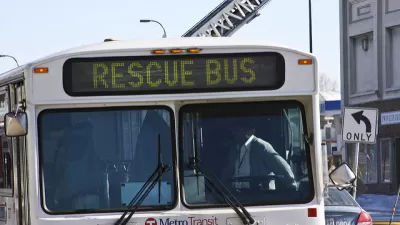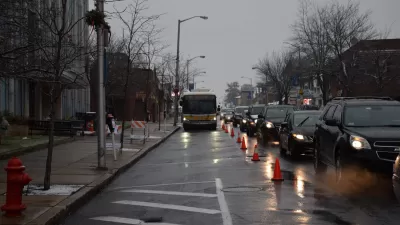A new Massachusetts Bay Transportation Authority program has quickly deployed bus infrastructure around the Boston area, focusing on neighborhoods where people are relying on the bus during the pandemic.

Cinnamon Janzer reports on the Rapid Response Bus Lanes program launched by the Massachusetts Bay Transportation Authority (MBTA), adding 14 miles of dedicated bus lanes in four regional municipalities (Boston, Chelsea, Somerville, and Everett).
"The 'Rapid Response' program can create new bus lanes, from planning to implementation, in roughly four months. That’s slightly faster than the average six to eight month time that the agency and its partner municipalities have been able to lay down lanes in the past," explains Janzer.
The program is offered as a benefit to riders impacted by reduced bus capacities and reduced service schedules during the pandemic—and specifically to provide efficient bus service to essential workers during the pandemic.
Since the beginning of the pandemic, low-income neighborhoods of color around Boston have held steady with ridership on public transit, while bus routes usually filled with high-wage earners heading downtown have been empty. The Rapid Response program was specifically designed to deliver first where ridership was likely to be durable during the pandemic, according to Janzer.
"To add an equity lens, [Eric] Burkman and [Melissa Duellea’s] teams used equity data from the Livable Streets Alliance and mapped that to the Rapid Response plans they were devising. This was used to 'truth check to make sure we weren’t accidentally being inequitable in our implementation,' Burkman says, as 'Boston region [riders] tend to be more people of color and primarily of lower incomes,'" writes Janzer.
FULL STORY: Boston Area Adds ‘Rapid-Response Bus Lanes’ for Pandemic Transportation

Study: Maui’s Plan to Convert Vacation Rentals to Long-Term Housing Could Cause Nearly $1 Billion Economic Loss
The plan would reduce visitor accommodation by 25,% resulting in 1,900 jobs lost.

North Texas Transit Leaders Tout Benefits of TOD for Growing Region
At a summit focused on transit-oriented development, policymakers discussed how North Texas’ expanded light rail system can serve as a tool for economic growth.

Why Should We Subsidize Public Transportation?
Many public transit agencies face financial stress due to rising costs, declining fare revenue, and declining subsidies. Transit advocates must provide a strong business case for increasing public transit funding.

How to Make US Trains Faster
Changes to boarding platforms and a switch to electric trains could improve U.S. passenger rail service without the added cost of high-speed rail.

Columbia’s Revitalized ‘Loop’ Is a Hub for Local Entrepreneurs
A focus on small businesses is helping a commercial corridor in Columbia, Missouri thrive.

Invasive Insect Threatens Minnesota’s Ash Forests
The Emerald Ash Borer is a rapidly spreading invasive pest threatening Minnesota’s ash trees, and homeowners are encouraged to plant diverse replacement species, avoid moving ash firewood, and monitor for signs of infestation.
Urban Design for Planners 1: Software Tools
This six-course series explores essential urban design concepts using open source software and equips planners with the tools they need to participate fully in the urban design process.
Planning for Universal Design
Learn the tools for implementing Universal Design in planning regulations.
Ascent Environmental
Borough of Carlisle
Institute for Housing and Urban Development Studies (IHS)
City of Grandview
Harvard GSD Executive Education
Toledo-Lucas County Plan Commissions
Salt Lake City
NYU Wagner Graduate School of Public Service





























